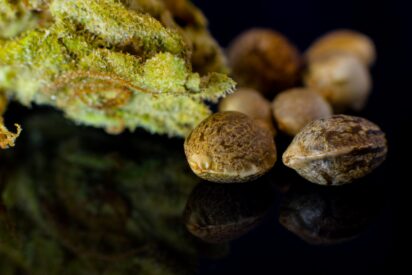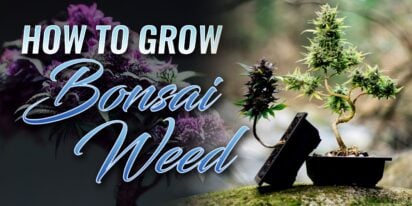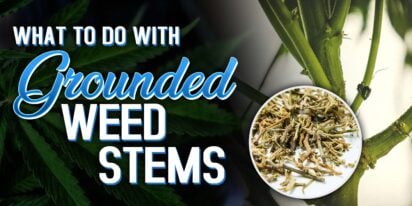
Are You 18 Or Over?
YesOr
No By clicking yes, you certify that you are over 18. By using this website, you agree to our legal disclaimer.605+ Cannabis Strains over 20 Breeders worldwide.
Table of Contents

When it comes to cannabis, most growers don’t focus on breeding and fertilizing their plants. It is common practice to only grow what you smoke, however, breeding your weed is also an essential and exciting part of the process.
Whether you’re new to growing or want to branch out into breeding, here’s everything you need to know about how to find seeds in weed.
The first step to understanding weed seeds is to know why they’re important. Cannabis plants, just like many flowers and crops, come in both male and female varieties. Female plants get pollinated and grow buds for consumption, while male plants produce seeds and pollen.
These seeds are essential for creating new plants, through which you can continue to grow your own. Since regular plants have a 50/50 chance of being male or female, by continuing the pollination of only a few plants you still gain new buds to smoke. So the constant growth will be beneficial for avid smokers.
Oftentimes, however, non-pollinated weed is considered best since the plant will have more cannabinoids in each bud. Because of this, most growers toss male plants once they’re identified.
“So if you are growing to smoke why keep male plants?” You may ask yourself. Well, the answer is quite simple: so you can continue to grow your own supply at home. Additionally, breeding creates new strains, and as any weed enthusiast will tell you, new strains are awesome.
Breeding can be an engaging process from start to finish, allowing you to have full control over what strains you grow and how many seeds you have to begin your production. Male plants also allow you to continue enhancing your grow, rather than waiting for your new seeds to ship.
Male plants grow the pollen while the females grow the buds. Despite what some people may say online, it’s impossible to tell whether a seed will be a male or female until a few weeks after sprouting. Once your plants are growing, look for these indicators:
If you’re using feminized seeds, most of your plants will be female. However, some of them may become hermaphrodites, meaning they can self-pollinate. In this case, you’ll notice both sex organs on the plant. If you are growing solely for consumption, this can become a problem. Luckily, you can read up on hermies and how to prevent them from creating seeds here.
Step Two: Allow for Pollination
There are two ways you can do this, depending on what you’re trying to achieve. You can take a surgical or a natural approach to pollination. The surgical option means:
This process works well to test a few new strains before committing to a new crop. Most high-end growers will recommend this method because it offers so much control over the situation.
The natural option means just letting your marijuana do its thing. Male plants produce a lot of pollen, and if you have fans blowing (or grow outdoors), a single male can pollinate many females. This method requires far less effort but may mean that your entire crop will wind up with seeds, so plan accordingly.
Males only produce pollen, while females create the seeds. The bud is where you’ll find the seed, and it takes about two to six weeks after pollination to develop. You can look at your buds to see if seeds are growing inside.
If you are a grower, you should already know how to harvest and dry buds, so that process is still the same. Simply crack open each bud and take out the seeds inside. They should be ready to grow within a month after drying.
However, if you are new to growing marijuana plants, this step-by-step guide can help you understand the entire process of harvesting and drying buds.
Once you start making new strains, it’s easy to grow more and see which combinations you can create. Also, as you go through different crops, you may discover some that you want to cross-pollinate with others. So, here are some tips to keep in mind when trying to get seeds:

In recent years, the discourse surrounding secondhand marijuana smoke has gained significant attention, paralleling the legalization and increas

In the realm of cannabis culture, the practice of "wake and bake" holds a significant place, accompanied by both supporters and skeptics. As exp

Introducing the robust indica strain known as Critical Mass weed, a harmonious fusion of Afghani and Skunk #1 genetics. Delve into its essence,

Fusarium wilt cannabis represents a significant threat to cannabis cultivation, necessitating a comprehensive understanding of its intricacies.

1980s were a time of profound cultural transformation, marked by iconic fashion, music, and movies. Alongside these trends, a unique facet of '8

[ez-toc] In the deep history of cannabis cultivation, there exists a captivating and creative practice that combines the art of cultivation wit

For growers looking to get better yields and healthier cannabis plants, it's important to understand and control the cannabis soil pH levels. pH

[ez-toc] In indoor gardening, maintaining an optimal temperature within your grow tent is crucial for the health and productivity of your plant

[ez-toc] Welcome to the delightful world of cannafudge crafting, where sweetness meets sophistication, and cannabis infusion adds a unique twis

[ez-toc] You’ve finished trimming your weed, but what about those leftover stems? Don’t throw them away! These seemingly useless bits can a

Are You 18 Or Over?
YesOr
No By clicking yes, you certify that you are over 18. By using this website, you agree to our legal disclaimer.